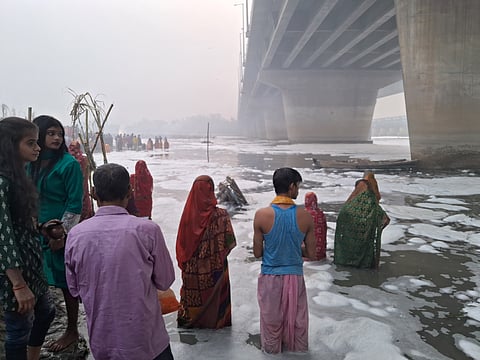
- Topics
- Feature
- Opportunities & Events
- About
- Hindi Portal
- Data
- Topics
- Feature
- Opportunities & Events
- About
- Hindi Portal
- Data

The Yamuna River has long been in the news, its waters sullied by pollution and infamous for the white toxic foam that floats across its surface, especially during celebrations like Chhath Puja. Despite the visibly dangerous state of the river, each year, devotees gather along its banks to offer prayers, braving the polluted waters in faith, often unaware—or perhaps unfazed—by the risks. I spent an evening on the banks of the Yamuna during this year’s Chhath Puja and witnessed firsthand the strange mix of chaos, celebration, and environmental neglect.
Many men and women stood waist-deep in water, offering prayers to the rising sun and the river. Among them was Savita, a resident of Bihar who has been living in Delhi's Shaheen Bagh for several years. She runs a small tea shop with her family. "We are quite a few in this locality," she said, her tone both resigned and firm. "There isn’t another place we can go to. In my building, there’s no space for this, and we can’t return to our hometown. My kids are small, and the trains are too crowded, so I decided to pray here instead."
Walking along the Yamuna riverbank, I spoke with several boatmen who know this waterway better than most. For them, the Yamuna isn’t just a river—it’s their livelihood. They earn between ₹200 and ₹500 per ride, mostly during Chhath Puja when visitors flock for boat rides. “I’ve been rowing here for 20 years. The Yamuna has changed tremendously—pollution is everywhere. Chhath Puja is when I make most of my income. The rest of the time, only a few young people come to shoot videos", shared one of the boatmen. Another boatman added, “I get itching and skin diseases after being in the water.
Devotees, driven by faith, waded into the foam-covered river to offer prayers, unfazed by its hazards. The scene was both enchanting and unsettling. Stalls selling toys, balloons, and ice cream lined the banks, with children tugging at parents for treats, adding a festive air that contrasted with the grim reality of one of India’s most polluted rivers. Among the Chhath devotees was a man from Shaheen Bagh, who had brought his family. "Chhath is very important for us," he said. "I know the water is polluted, but for us, it’s sacred. We’ve been celebrating here for five years."
The Yamuna, originating from the Champasar Glacier in the Himalayas, flows 1,376 kilometers before merging with the Ganges at Allahabad. In Delhi’s 22-kilometer stretch between Wazirabad and Okhla barrages, it transforms into one of the most polluted sections, receiving nearly 50% of the city’s untreated sewage. Dissolved oxygen levels in parts of the river have dropped to zero, rendering it uninhabitable for aquatic life. Despite this, the Yamuna supplies 70% of Delhi’s drinking water. Rapid population growth, industrial demands, and 19 canals dumping sewage and waste daily continue to worsen its plight.
A Hindi poster stuck at the back of a truck reads, "Yamuna Ji dur hai, jana jarur hai" (Yamuna Ji is far, but visiting is a must). The Delhi High Court has again banned celebrations on the riverbanks, citing environmental and health concerns. "Bans are announced every year, but no real effort is made to clean the Yamuna. Authorities offer hollow promises, blaming devotees instead of addressing the larger pollution crisis. Why not focus on real solutions and improving the river’s health", says Harshit, a devotee at the riverbank.
As night fell, the paradox of the Yamuna deepened. Celebrating Chhath Puja in toxic water, we confront our dependence on this river—as a sacred symbol and a lifeline. Until urgent steps are taken to clean and protect it, the Yamuna will remain a contradiction: revered and poisoned, life-giving yet dying at the hands of those it sustains.